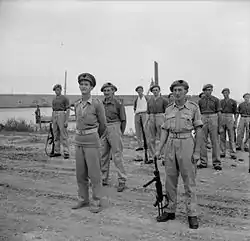Operation Tombola
During World War II, Operation Tombola was a major Special Air Service raid on German rear areas in Italy.
| Operation Tombola | |||||||
|---|---|---|---|---|---|---|---|
| Part of Western Front | |||||||
_Italy_-_September_19%252C_2011_-_panoramio.jpg.webp) Albinean Hills | |||||||
| |||||||
| Belligerents | |||||||
|
|
| ||||||
| Commanders and leaders | |||||||
|
|
| ||||||
| Strength | |||||||
|
50 men 2nd Special Air Service ~50 Italian & Russian partisans | LI Gebirgs Corps (elements) | ||||||
| Casualties and losses | |||||||
| 3 killed & 7 Wounded | 50-60 killed | ||||||
Operation
Fifty men parachuted to the Cusna Mountain area (Reggio Emilia) between 4 and 24 March 1945, under command of Major Roy Farran and helped from the SOE mission "Envelope" under the command of Michael Lees. A number of Allied airdrops provided weapons for the force which included local resistance fighters and 70 escaped Soviet POWs.

They were able to attack the German LI Gebirgs (Mountain) Corps headquarters, which was located at two villas in Botteghe d'Albinea in the hills above Reggio Emilia. In that attack on the night of 27 March 1945, the Germans sustained 50–60 casualties (including an unknown number killed). Three SAS personnel were killed in action at Villa Rossi, and about seven SAS and partisans were wounded (four British, two Italians and a Russian).
The attack was carried out to the sound of a Scottish piper, David Kirkpatrick (1924–2016), wearing a kilt. Kirkpatrick had volunteered to be dropped into the area, to identify the operation as British – so that reprisals would not be carried out against the local population. [1]
Operation Tombola continued until 23 April and the raids included the cutting of roads and shelling of a number of installations . Just as important as the 300 or so Germans killed and 200 captured, was the number of Axis defenders moved from other duties to secure the area. A number of Allied airmen, who were being hidden by civilians in the area, were also returned to friendly lines.
Aftermath
The commander of the operation, Roy Farran, published his account in the book Operation Tombola (Special Forces Library, Arms and Armour Press, 1986). The BBC series Secret War narrated by Alisdair Simpson (Acorn Media) in 2011 focuses on the exploits of Roy Farran and Michael Lees in the episode "SAS Italian Job". The operation is narrated also in the TV mini-series "Great SAS missions" (2004).
A book written in Italian Il bracciale di sterline by Matteo Incerti & Valentina Ruozi (Aliberti April 2011) details for the first time the operations with the use of British, Italian, and German documents. A second book Il paradiso dei folli (Imprimatur-Aliberti 2014) by Matteo Incerti to, focused on the war and post war experience of several participants of this secret mission. "Il suonatore matto" (Imprimatur 2017) also written by Matteo Incerti focused about the life of David 'mad piper' Kirkpatrick. Incerti found documents and memory who prove that the sound of Kirkpatrick's bagpipe and the sacrifice of the three SAS soldiers killed in action (Riccomini, Bolden, Guscott) in Villa Rossi, made the Germans believe that Tombola was a conventional military attack, rather than a "partisan" action. As a result the Nazis didn't inflict reprisals on the civilian population of Albinea.
During the second part of Operation Tombola, on 21 April 1945 action in Torre Maina (Modena) also the 2 SAS paratrooper Justo Balerdi-Robert Bruce was killed in action. He was a Basque antifascist, republican, and a former member of the French Foreign Legion. Bruce was the only Basque to fight with the British SAS in World War II. The story of Justo Balerdi-Robert Bruce appears in the books "Il bracciale di sterline" and "Il suonatore matto".
References
- "The Incredible Story of Scots piper who played through SAS raid". www.pressreader.com. The Scotsman. 2018-11-01. Retrieved 2018-12-23.
Further reading
- Lewis, Damien (2018). SAS Italian Job: The secret mission to storm a forbidden Nazi fortress. London: Quercus Editions. ISBN 978-1-78747-516-8. Retrieved 2020-12-12.